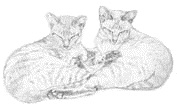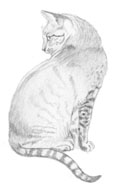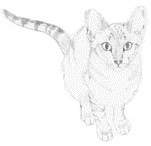| What are the SENSES of a cat ? |
| |
|
| THE HEARING |
| |
His hearing is particularly sensitive in the high frequencies. Perceives ultrasound to 50,000 Hz while the human ear is limited to 15 000Hz his horn Horn can be rotated through twenty-seven muscles, which he lets you rotate each ear independently to pinpoint the source of a noise and distance.
Deafness of white cats being debated today. 60 to 80% of white cats with blue eyes are deaf. This deafness is linked to the white (gene "W"). Schematically, we can say that all white cats are genetically deaf in general. This anomaly, although present at the genetic level is not always expressed in all cats. Thus, whether the defect is hidden and the ear develops normally, is the tare occurs and in this case the degeneration is complete: the cat is totally deaf to the affected ear. Knowing that a cat has two ears and that the anomaly does not always affect both ears in the same way, three cases: deafness is bilateral, unilateral or absent.
It is indeed demonstrated that the W allele, originally of the color "white dominant", is directly responsible for degeneration of the inner ear, resulting deafness. The kitten is born normal but around the age of one week, his inner ear, instead of continuing to grow undergoes progressive deterioration. Degeneration is usually complete in three weeks. |
| |
|
| VIEW |
| |
The view is its primary meaning. Its field of view is wider than human: 187 ° against 125 °, which remains far from the absolute record of the animal world.
Light intensity influences the shape of the pupil: elongated narrow slit in bright light, it expands into a perfect circle in the dark. Contrary to popular belief, he is unable to see in complete darkness. However, it is much more powerful than the human eye in the dark. At night, the bright eye appearance is due to a layer of cells in the retina called the tapetum lucidum, which acts as a mirror and returns the perceived light, which is passed a second time in the retina and thus multiplies by two his eyesight in the dark.
However, it seems (this is still debated) that the cat does not perceive the color red and that, in general, it differs very little detail. His vision is grainy on still images while a moving object appears more clearly to him (eg prey movement).
A peculiarity of the cat's eye is in addition to the lower and upper eyelids, it is protected by a third eyelid, third eyelid. It closes from the bottom edge of the inner corner of the eye outward. When she is not completely closed, it is often a sign of a health problem in cats (digestive disorders, parasites often or enteritis). Cats can have eyes of different colors like blue, green, yellow, brown ... |
| |
|
| SMELL |
| |
The sense of smell is of great importance in the social life of the cat to mark its territory. Moreover, it is his sense of smell that enables it to detect rotten food and poison. It has two hundred million olfactory terminals, against five million to humans. |
| |
|
| TASTE |
| |
The sense of taste is developed in cats less than men, however: in the adult cat, there are 250 taste buds with 40 to 40,000 taste buds. Unlike the dog, the gustatory sense of the chat is located at the tip of the tongue, allowing him to taste without swallowing. It is sensitive to bitter, acid and salty, not sweet. |
| |
|
| TOUCH |
| |
His sense of touch is also well developed. His whiskers (whiskers, but there are also the legs, under the chin, eyebrows) show him the proximity of obstacles, even in total darkness, allowing it to detect air pressure changes. They also allow it to measure the width of a passage. It is important not to cut because the cat would be destabilized. The pads filling his paws are very sensitive to vibrations and his skin is studded with highly sensitive tactile cells. |
|














